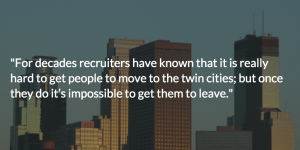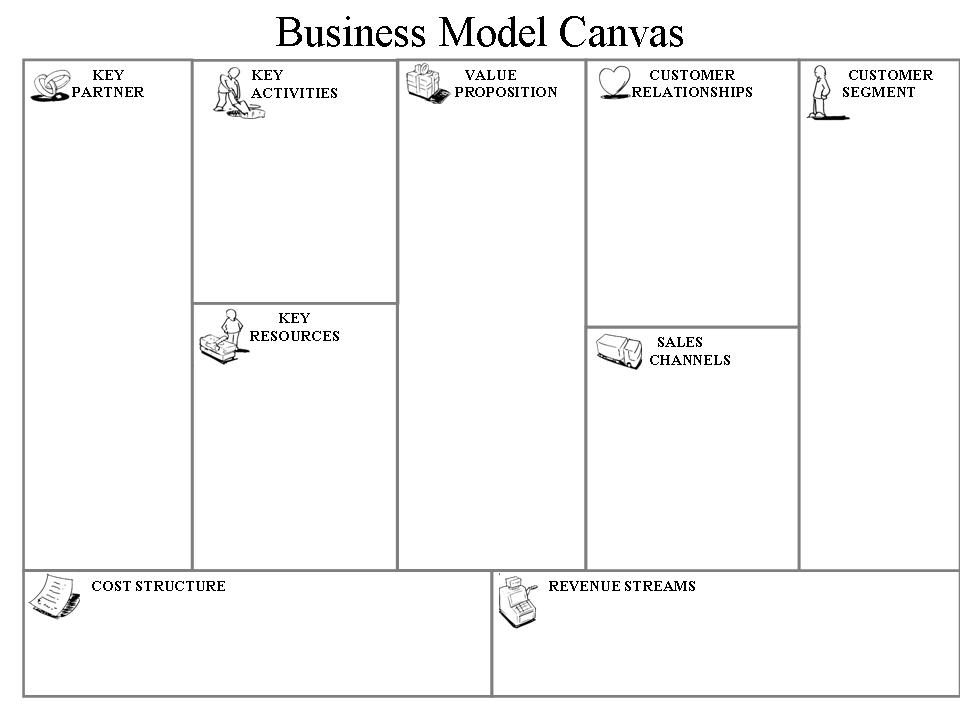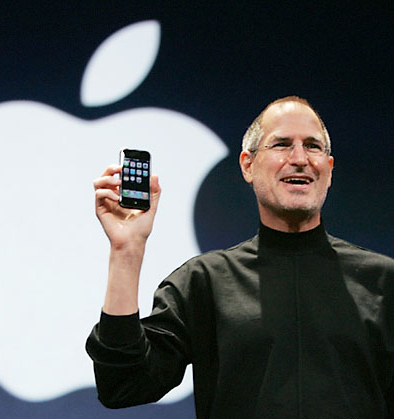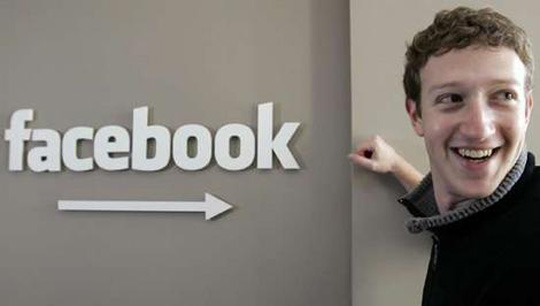Leadership Catalyst Blog

Exercise Mythbusters for Vistage CEOs
Motivation / 09.03.2016
I meet with over 70 CEOs, Business owners, and executives every month in the four Vistage CEO private advisory boards I lead. Most of the CEOs in my groups understand the importance of regular exercise for keeping them at the top of their games, however, a majority of them, including myself, have bought into several myths about how to exercise. Many CEOS made New Year’s resolutions about improving their health, but like most of us, have fallen off of their good intentions 30 days into the new year. Some of the CEOS who have been successful in developing a discipline of exercising daily don’t realize that they are wasting a lot of precious time due to fitness myths, and they are being counterproductive in their efforts.
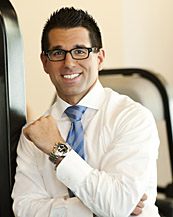 Luke Carlson is a Vistage member and speaker, exercise physiologist, former NFL strength coach, competitive marathoner, and one of the most respected experts in evidence based resistance exercise. Luke recently met with my Vistage groups to help us dispel some fitness myths and design an intelligent exercise program that would require no more than two 30-minute exercise sessions a week. I have worked with Luke to outline a few of the most dangerous myths below.
Luke Carlson is a Vistage member and speaker, exercise physiologist, former NFL strength coach, competitive marathoner, and one of the most respected experts in evidence based resistance exercise. Luke recently met with my Vistage groups to help us dispel some fitness myths and design an intelligent exercise program that would require no more than two 30-minute exercise sessions a week. I have worked with Luke to outline a few of the most dangerous myths below.
Myth 1. “Cardio” is the key to weight loss.
Mythbuster 1. If your goal is weight loss, the most effective approach is always a combination of improving your eating habits and then recharging your metabolism by increasing muscle mass via strength training.
Go to any health club and you will see scores of people laboring on treadmills, elliptical machines, and spin bikes. Ask them what their goal or objective is and they will tell you that they are trying to burn calories or lose weight. What they fail to understand is that while they are burning more calories during the one-hour that they are exercising, their body is actually burning fewer calories for the remaining 23 hours of the day following their workout. The reason? After we perform a bout of cardio or aerobic exercise, the number of calories we burn the remainder of the day, known as Energy Expenditure due to Physical Activity or simply “EEPA” decreases. Stated otherwise, after we perform a bout of cardio, we find a way, both consciously and subconsciously to be less active and expend less calories the rest of the day. In controlled experiments, subjects who exercise 60-minutes per day expend no more calories at the end of the day compared with subjects who perform no cardio whatsoever.
 Don’t believe it? Here is another factoid: People who train for and then run a marathon (often with a hidden intent to lose weight), despite hundreds of hours of running (and literally tens of thousands of calories expended), on average, end up weighing the same or more on the day of the marathon compared to before they started their training. Additionally, they fail to improve their body fat percentage. This is in no way denigrating cardio. Instead, we simply need to understand that cardio isn’t very effective for weight loss; the primary benefit of cardio is improving your cardiovascular system and health, as its name suggests.
Don’t believe it? Here is another factoid: People who train for and then run a marathon (often with a hidden intent to lose weight), despite hundreds of hours of running (and literally tens of thousands of calories expended), on average, end up weighing the same or more on the day of the marathon compared to before they started their training. Additionally, they fail to improve their body fat percentage. This is in no way denigrating cardio. Instead, we simply need to understand that cardio isn’t very effective for weight loss; the primary benefit of cardio is improving your cardiovascular system and health, as its name suggests.
Myth 2. The best way to increase muscle mass and muscle strength is by strength training several times a week.
Mythbuster 2 Doing resistance training more than twice a week will generally slow your results, and for most executives, you will get 85% of the benefit doing resistance training only once per week.
We reap the many benefits of strength training not during the training session itself, but during the recovery from the training session. The training session should be viewed as the stimulus, and in order to respond to the stimulus, we need to make sure we provide adequate rest and recovery. As Luke explained, building strength is similar to building a callus. If you rub a spot on the back of your hand with a piece of sandpaper every few days, you will soon build up a callus (the callus is a response to a stimulus). If you were to rub your hand too frequently, you will gain a blister rather than a callus. It is often our fervor for producing better results that impedes our progress. With strength training, less is more.
 Myth 3. The best way to increase your strength is to perform three sets for each exercise.
Myth 3. The best way to increase your strength is to perform three sets for each exercise.
Mythbuster 3. One properly performed set of each exercise will stimulate all of the health and muscle building benefits of strength training.
Muscles can’t count, so it doesn’t matter if you end up with 7 reps or 17 reps; instead, focus on continuing each set to the point of “momentary muscle failure”; the point where another perfect rep can’t be performed. The main focus should be to lift and lower the weight slowly, thus eliminating momentum. This makes the exercise more effective as it maximizes the tension on your muscles while also making the exercise safe because the forces your joints are exposed to are minimized.
Luke Carlson’s exercise prescription for the busy executive:
- Strength train once or at most twice per week, with each workout consisting of one set of 8-12 exercises done to momentary mujscle failure and lasting approximately 30 minutes.
- Strength train once or at most twice per week, with each workout consisting of one set of 8-12 exercises done to momentary mujscle failure and lasting approximately 30 minutes.
- Perform one to two high intensity interval cardio training sessions per week, with each session lasting 30 minutes. You can walk/run or use an elliptical, bike or treadmill. Warm up for 5 minutes and then do 10 two minute intervals where you exercise as hard as you can for 30 seconds and then rest for 90 seconds. As your conditioning improves, exercise as hard as you can for 1 minute and then rest for 1 minute. The key to improving over time is to keep increasing the intensity of your workouts by increasing your speed, the incline of your treadmill, or the resistance of your elliptical. Finish off your workout with 5 minutes of light exercise or cool down
- Lead an active lifestyle and do activities you enjoy and consider leisure rather than “working out.” It can be biking, walking, golfing, or playing with the kids. The key is that it shouldn’t feel like a chore. If you love to run or jog, do it.
- This total time commitment of 1-2 hours of focused, intense exercise per week and an active lifestyle will maximize fitness, stimulate a myriad of health benefits, and bolster an executive’s performance.
Luke’s Mythbusters have inspired myself and eight of my Vistage members and several of their spouses to try out his methodology at the Discover Strength gym. We have been pleased with the results thus far and we are spending the extra time previously devoted to the treadmill with our families and friends.
Read More >>
New Ammunition in the Twin Cities War for Talent
All Blog Posts, Talent Acquisition, Talent Management / 10.03.2015
For decades recruiters have known that it is really hard to get people to move to the twin cities but that once they do it’s impossible to get them to leave. An article in the March 2015 issue of the Atlantic entitled “The Miracle of Minneapolis” penned by Derek Thompson highlights a compelling economic reason behind this adage: no other city mixes affordability, opportunity, and wealth so well.
Minneapolis – St. Paul was one of only three major metro areas to be on two top 10 economic lists that recently came out. The first is a Trulia study that looked at homeowners’ monthly payments in each city relative to the areas median income. The second a Harvard-Berkeley study examining which cities have the highest intergenerational mobility. Many metropolitan areas seem to have caused a trap for their younger residents in which they cannot afford housing and find a job that positions them well for the future. The Twin Cities seems to have realized both affordable housing and upward job mobility.
Other top ten lists that the Twin Cities makes such as the most bike friendly city, Money’s best place to live, and most fit city are just icing on the cake. The fact that young families can come here for great careers and affordable housing is very compelling value proposition for millennials and this article is a great arrow in your quiver for attracting top talent.
How has the Twin Cities done this and continued to make its mark as a strong business friendly region? According to Thompson, “The Twin Cities’ housing and tax-sharing policies have resulted in lots of good neighborhoods with good schools that are affordable for young graduates and remain nice to live in even as their paychecks rise. This, in turn, has nurtured a deep bench of 30- and 40-something managers, who support the growth of large companies, and whose taxes flow to poorer neighborhoods, where families have relatively good odds of moving into the middle class.”
A fact often touted in the region is that the Twin Cities has more Fortune 500 companies per capita than any other metropolitan area. One strong reason for this is the deep blend of 30 and 40 something talented middle managers that help build and grow those companies.
As you recruit out of state talent for your business, let them know that the Twin Cities, along with your company, is a place that grows, fosters and retains talent like no place else.
Read More >>
CEOs – Quit While You Are Ahead?
Change, Vistage Peer Groups / 07.01.2014
Long tenure is often perceived as a measure of success and a sign of CEO competence. But does the data bear this out? Not according to this INC. Magazine article “CEOs: Why You Should Quit While You’re Ahead” which offers some insightful findings about CEO tenure. The study focuses primarily on large companies but even in small to midsize privately held companies, can the CEO stay too long?
Several experts maintain that the CEO is on a steep learning curve during the first couple of years but will really hit his or her stride in years 3-5. After 5 years, however, the company’s results begin to decline. According to Michael Jarret at INSEAD, “The team’s research found that when a CEO stays over five years, customer relationships, product safety and quality, and financial returns will all decline.”
One reason for the decline is that you are more likely to settle for the status quo. “After the initial rush of enthusiasm and energy, established routines and networks can smother the drive for innovation,” Jarrett writes. A second reason for the decline is that you stop learning. “… as CEOs accumulate knowledge and become entrenched, they rely more on their internal networks for information, growing less attuned to market conditions,” the authors say.
One way to avoid this decline is suggested in the title of the article: CEOs: Why you should quit while you’re ahead. In certain situations a CEO choosing to step down may very well be the wise or heroic thing to do. On the other hand, installing a new CEO every 5 years is not practical for many companies, especially small and medium size businesses. And why would someone who has persevered through many challenges and worked hard to rise to the top leadership role want to quit?
Quitting your job as CEO will certainly bring about change for your company (for better or worse). Another path forward is to join a CEO Peer Advisory Board of independent CEOs who will continually challenge your thinking, push you out of your comfort zone, and keep you externally focused and learning.
Read More >>CEOs in my Vistage Peer Group candidly reveal the impact the group has had on their businesses
All Blog Posts, Vistage Peer Groups / 13.02.2012
A little over a year ago, I submitted a post citing research that Vistage CEOs outperformed their non-member peers. (http://theleadershipcatalyst.wordpress.com/2010/10/31/research-backs-claims-that-vistage-ceos-outperform-their-nonmember-peers). The bottom line of that article was that
“… in one of the toughest economies in history, Vistage member companies averaged 5.8 % revenue growth, while nonmembers averaged a (9.2%) revenue decline. In future posts, we will explore the factors that contribute to that sizeable performance difference.”
The purpose of today’s post is to make good on that promise. Most of the CEOs who have been in the Vistage Peer Group that I chair have seen significant improvements in their business since they joined. Our group currently has 18 members from a diverse set of industries and backgrounds and businesses that range in size from $5M to over $800M in annual revenues. To better understand how belonging to Vistage increased their effectiveness and enhanced their lives, I took a little flip camera to one of our monthly executive coaching sessions and asked them. (To see all 12 videos, click on the CEO VIDEOS tab at the top of the page.)
For purposes of this blog post, I selected the responses of 3 CEOs from varying company sizes, industries, and business models. Some were struggling a year ago, and others were doing well. All are doing better now and point to their Vistage membership as a key factor in their successes. Below is a brief outline of their situations and links to their 2 minute YouTube videos where they share how Vistage made a difference.
Gene Earhart is the CEO of Wellington Security Systems, a small family business (< $5M) he owns and operates in partnership with his brother-in-law. Gene is a lifelong entrepreneur, who decided to start this business with his family before finishing college. His company designs, installs, and services electronic security systems for the commercial market, and they have 10 employees in a single location. He credits Vistage with helping him turnaround his company to achieve the most profitable year in their 30-year history.
Click here to see a 2 minute YouTube video of Gene telling his story.
Mike Martin is the CEO and owner of Carlson & Stewart Refrigeration ($10 – $25M), which designs, installs, and services industrial and commercial refrigeration systems. An engineer by training, he has worked most of his career at his company, and bought it and became CEO about 8 years ago. Based in Marshall MN, he has about 50 employees in 3 locations in Minnesota and South Dakota. He says that he would not have been able to double the size of his business last year without Vistage.
See Mike’s 2 minute YouTube video by clicking here.
Jim Fisher is the CEO of Midwest Sign, a privately owned business ($100M+) that distributes sign making equipment and supplies. They have about 200 employees in 9 locations throughout the western half of the U.S.. Jim is trained as an accountant, and has spent most of his Career with Midwest. He was thrust into the CEO position about 5 years ago with the sudden and unexpected death of the beloved company owner and founder. After being pounded by the recession, he and his team have hit the restart button on their growth engine, and last year they achieved double-digit growth and record profitability. He points to Vistage as helping him become more strategic, getting him more on top of the business, and showing him how to get a lot more done in less time.
Click here to see more about how Vistage has helped Jim elevate his game as a CEO.
A key theme that cuts across all of these stories is that “None of us is as smart as all of us”. Having an advisory board of fellow CEOs that have your back and challenge your thinking is a tremendous competitive advantage.
Read More >>How to Increase Accountability
All Blog Posts, Coaching, Performance Management, Vistage Peer Groups / 22.11.20111 comments
In a recent Vistage meeting, a theme that emerged was how to better hold others accountable. People often agree in meetings to things with “their fingers crossed”, and don’t deliver on commitments. While this is the subject of many books and training programs, one quick fix is to assure that you have a “Level 5” agreement.
James Newton, CEO of Newton Learning corporation and longtime Vistage Speaker, outlines 5 levels of agreement. Below is a brief description of each agreement level, illustrated by a simple example of setting up a golf game. As you read the scenarios, consider the level of agreement you have achieved in those instances where people have not delivered on commitments.
Level 1 Agreement: No agreement at all.
Brian: “Hey Mike, what do you say we play golf after our next meeting.”
Mike: “There’s an idea.”
Level 2 Agreement: Likes the idea, but no agreement.
Brian: “Hey Mike, let’s play golf after our next meeting.”
Mike: “Good idea!”
Level 3 Agreement: Reluctant agreement–but no commitment to do anything.
Brian: “Mike, Let’s play golf after our next meeting.”
Mike: “Man, I am really swamped, I better not.”
Brian: “Come on Mike, this will probably be our last chance before snowfall.”
Mike: “OK, I’m in.”
Level 4 Agreement: Enthusiastic agreement–but no commitment to do anything.
Brian: “Mike, let’s play golf after our next meeting”
Mike: “Great idea! Count me in.”
Level 5 Agreement: Specific commitment of who is going to do what by when, stated by the accountable person.
Brian: “Mike, let’s play golf after our next meeting”
Mike: “Great idea!” I’m in.”
Brian: “Where do you want to play.”
Mike: “Let’s play at my club. I’ll make a tee time for after our meeting.”
Brian: “How about if we have our meeting at your club so we can tee off right after that.”
Mike: “Great, I’ll meet you at my club for our monthly one-to-one on Friday at 2:00 pm and make a tee time for 3:30 pm.”
♦♦♦♦♦♦♦♦♦♦♦♦♦♦♦♦♦♦♦♦♦♦♦♦♦♦♦♦♦♦♦♦♦♦♦♦ LEADERSHIP CATALYST TIP ♦♦♦♦♦♦♦♦♦♦♦♦♦♦♦♦♦♦♦♦♦♦♦♦♦♦♦♦♦♦♦♦♦♦♦
Accountability increases with the level of agreement. If you are having trouble holding people accountable, push for a Level 5 Agreement, with a specific commitment to what is going to get done, by whom, and by when that is stated by the accountable person. It may take a little longer, but it will increase accountability and execution–and will save you a lot of time in the long run.
♦♦♦♦♦♦♦♦♦♦♦♦♦♦♦♦♦♦♦♦♦♦♦♦♦♦♦♦♦♦♦♦♦♦♦♦♦♦♦♦♦♦♦♦♦♦♦♦♦♦♦♦♦♦♦♦♦♦♦♦♦♦♦♦♦♦♦♦♦♦♦♦♦♦♦♦♦♦♦♦♦♦♦♦♦♦♦♦♦♦♦♦♦♦♦♦♦♦♦♦
Is your business model dying? How do you know?
All Blog Posts, Business, Strategy, Vistage Peer Groups / 30.10.2011
- Why did XEROX give the mouse and “windows” technology to APPLE?
- Why didn’t AT&T invent SKYPE?
- Why didn’t MICROSOFT invent GOOGLE?
- Why didn’t BLOCKBUSTER invent NETFLIX?
- What changes have you made to your business model in the last couple of years?
- If an employee came to you with a “game changing” idea that might threaten your core business in the short term, would you listen to them?
- Is your business model dying, how do you know?
A Death in Cupertino | The Right Kind of Tyrant
All Blog Posts, Motivation, Vistage Peer Groups / 11.10.2011
“ Remembering that I’ll be dead soon is the most important tool I’ve ever encountered to help me make the big choices in life; because almost everything —all external expectations, all pride, all fear of embarrassment or failure — these things just fall away in the face of death, leaving only what is truly important. Remembering that you are going to die is the best way I know to avoid the trap of thinking you have something to lose.
You are already naked. There is no reason not to follow your heart.”
Steve Jobs
1955-2011
Founder and CEO of Apple
From his Stanford University Commencement Address, 2005
Picking an article to share with you about the passing of Steve Jobs is an impossible task with so many that knew him sharing their impressions on one of the most important entrepreneurs in history.
We have a saying in Vistage: “We invite CEOs to our group but human beings show up.” To get a sense of what was important to this truly remarkable and essestial human being, I’d like to share with you the 15 minute video of his 2005 Stanford Commencement speech. I found it incredibly inspirational, and I hope you will share it with your friends, family and employees.
This inspiring speech, however, should not blind us to the fact that Steve Job’s management style was often very different from the warm, fuzzy and friendly feeling you get from using his products or visiting the Apple store at the mall. For some insights into the management style that made Apple the most valuable company in America, check out this article which suggests that if Steve Jobs was often a hard man to work for, he was, in fact, “The Right Kind of Tyrant.”
Thanks, Steve, for all you have given us. Rest in Peace
Numerous articles have been written about the resignation this past week of Steve Jobs as CEO of Apple (though he remains as chairman). I could list a dozen that I find compelling and you can easily find them online or elsewhere. It would be difficult to find one that does not celebrate his many successes. Fortunately, I found one that focuses on his many failures…and how they were indispensible to his breathtaking successes. Check out “Steve Jobs: America’s Greatest Failure” ; required reading for any entrepreneur….or those who manage one.
Read More >>Jay Cutler of the Chicago Bears created a lot of controversy last week when a knee injury prevented him from finishing the NFC conference championship game against the Green Bay Packers. Many questioned his toughness, and believed he had “quit on his team” during their most important game of the year.
An MRI later showed the injury was indeed serious, and confirmed the decision for him not to play. It did not, however, excuse the lack of leadership and poor attitude he displayed during the remainder of the game. Instead of cheering on his teammates or supporting the backup quarterbacks, cameras repeatedly caught him sulking on the sidelines, listening to his iPod.
The lesson for CEOs is that, like Jay Cutler, we are always “on camera” in our organizations. We need to periodically check ourselves to make sure we haven’t succumbed to bad leadership habits and make sure that we aren’t displaying a poor attitude, which can be contagious for the rest of our organization.
Mike Myatt makes a compelling case that attitude reflects leadership and is a decision.
“Show me a CEO with a bad attitude and I’ll show you a poor leader. While this sounds simple enough at face value, I have consistently found that one of the most often overlooked leadership attributes is that of a positive attitude. As a CEO, how can you expect to inspire, motivate, engender confidence, and to lead with a lousy attitude? The simple answer is that you can’t…it just won’t work. CEOs with bad attitudes will not only fail to engage their workforce, but they will quickly find themselves shown the door as their attitude’s impact on performance becomes visible to the board.”
Do you need an attitude adjustment? Click here for a 5 point checklist to check yourself, and some compelling statistics about why you may want to change.
Read More >>Research backs claims that Vistage CEOs outperform their nonmember peers.
All Blog Posts, Vistage Peer Groups / 31.10.20101 comments
In last week’s post, I featured a CNBC broadcast regarding Vistage Member CEOs forecasting short term growth for small companies over the next two quarters. In that report was a caveat that Vistage CEOs may not be a totally representative sample of Small Business CEOs, because independent research shows that they consistently outperfom peer nonmember companies. I asked Vistage International to share their evidence, and was impressed with the research they produced. As can be seen from the graphs below, a Vistage Sample of 1265 member companies was compared with a statistically matched sample of about a million D & B nonmember companies. Over the period 2006 though 2009, Vistage companies outperformed nonmember companies on CAGR by15 percentage points. Moreover, this trend was consistent across all major business segments, ranging from a 13.2 percentage point difference in the Transportation and Communication Sector, to a 25.7 percentage point difference in the Wholesale Trade sector. In other words, in one of the toughest economies in history, Vistage member companies averaged 5.8 % revenue growth, while nonmembers averaged a (9.2%) revenue decline. In future posts, we will explore the factors that contribute to that sizeable performance difference.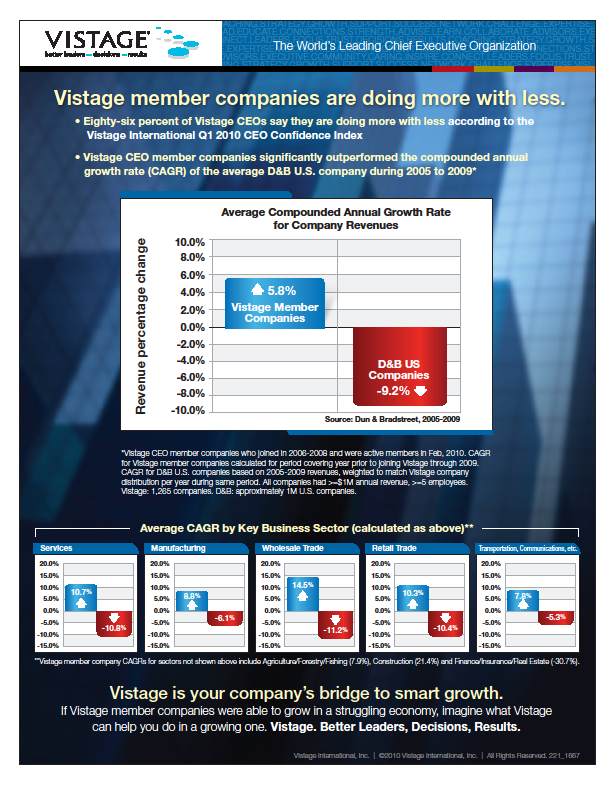
Read More >>
CNBC reports that 67% of Vistage CEOs Predict Revenue Growth for their Companies
All Blog Posts, Vistage Peer Groups / 23.10.2010
Rafael Pastor appeared as a guest on CNBCon Monday afternoon wherein he released a new economic survey of Vistage CEOs outlook on the economy. In this 5 minute CNBC video clip (Please endure the 20 second lead ad), Pastor relates that the Vistage CEOs surveyed (representing over 14,000 member companies worldwide, with 10,000 member companies in the USA) are experiencing a modest lift in this economy, and are forecasting growth two quarters out, and a better economic forecast in 2011 than the market specialists are forecasting. (Note: Vistage CEOs may not be a representative sample of small businesses because independent research shows that Vistage member companies consistently outperform their non-participating peers.) Despite not being a totally representative sample, the Vistage CEO Confidence Index is a reliable leading indicator of GPD growth two quarters out. Pastor goes on to say that Vistage member companies do not forecast significant job growth in 2011. Rather, Vistage CEOs are focused on doing more with less, focusing on international markets, technology productivity enhancements to reduce costs, and operating their companies more profitably with little intention of rehiring many of those that were laid off earlier in the recession.
Other interesting survey highlights include:
- 92% expect health care costs to go up
- 67% say their business will be hurt if the Bush tax cuts are not extended
- 62% expect Republicans to control the November elections
- 52% say they would not start a new business in the current economic climate
CEOs, like HIPPOs, at times need to avoid trampling others.
All Blog Posts, Vistage Peer Groups / 08.08.2010

Walking into my client’s building, I noticed a large crew of maintenance workers feverishly manicuring the company grounds. When I asked the new CEO what had prompted such frenzied activity, he shook his head and said that earlier that morning, he had commented to the receptionist that he was having a hard time keeping up with his lawn, with all of the rain they had been having. His comment had been misunderstood by a bystander as criticism of how the grounds were being maintained, and reinforcements had been dispatched to manage the “grounds keeping crisis”. This was my first introduction to the “HIPPO” effect, which is an acronym for how the Highest Paid Person’s Opinion can ripple through an organization.
The effect is even greater when a CEO has strong views about an issue. For example, Steve Jobs pushed through the introduction of the new iPhone, even though problems about the antenna design had been known for months.
Suzanne Lucas (a.k.a. Evil HR Lady) suggests 5 tips for how employees can avoid being trampled by a HIPPO. I think they are pretty good, and I recommend that CEO’s not only read them, but distribute them and discuss them at a team meeting to assure their opinions are being constructively challenged.
CEOs, like HIPPOs, at times need to avoid trampling others.
Read More >>What can CEOs learn from a twenty-something college dropout?
All Blog Posts, Vistage Peer Groups / 29.07.2010
I often talk to fellow CEOs about their development, and who they would like to have in a CEO peer group with them. Like most of us, they want someone who has already been down the road that they are traveling, and can point out the opportunities and landmines they may encounter on their journey. They typically think of someone who is more experienced (and older) than themselves who can challenge them and hold them accountable.
However, Joe Frontiera wrote an article in this week’s Washington Post entitled “Facebook’s leadership: Dissecting Mark Zuckerberg “ that challenges this notion that lessons must be learned from someone more experienced. In this one page article, he identifies lessons that can be learned from this 26 year old’s brief tenure as the co-founder and CEO of face book. Given Facebook has been estimated to be worth as much as $35B, these are lessons worth heeding. The one page article is worth a 5 minute read to learn more about the lessons highlighted below.
♦♦♦♦♦♦♦♦♦♦♦♦♦♦♦♦♦♦♦♦♦♦♦♦♦♦♦♦♦♦♦♦♦♦♦ LEADERSHIP CATALYST TIPS ♦♦♦♦♦♦♦♦♦♦♦♦♦♦♦♦♦♦♦♦♦♦♦♦♦♦♦♦♦♦♦♦♦♦♦
The key lessons learned in observing a 26 year old, highlighted by Frontiera are:
- “Believe in the vision.”
- “Execution can trump innovation.”
- “Mistakes become mistakes when you let them.”
- “The Devil is in the details.”
- “Ownership matters.”
♦♦♦♦♦♦♦♦♦♦♦♦♦♦♦♦♦♦♦♦♦♦♦♦♦♦♦♦♦♦♦♦♦♦♦♦♦♦♦♦♦♦♦♦♦♦♦♦♦♦♦♦♦♦♦♦♦♦♦♦♦♦♦♦♦♦♦♦♦♦♦♦♦♦♦♦♦♦♦♦♦♦♦♦♦♦♦♦♦♦♦♦♦♦♦♦♦♦
Read More >>
